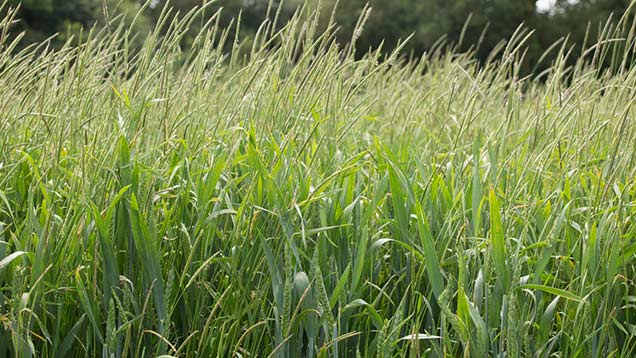Hybrid barley can keep blackgrass under wraps
 © Tim Scrivener
© Tim Scrivener Winter barley is able to suppress blackgrass better than winter wheat and hybrid barley is even more effective at controlling this pernicious grassweed, according to independent trials.
In a very bad blackgrass site in Lincolnshire, weed levels were so high that an equivalent of 4.5t/ha of blackgrass seed was recorded in a wheat crop, while levels were lower in barley.
See also: New herbicide option for controlling resistant blackgrass
In the trial, conducted by weed expert John Cussans at crop consultants Niab, conventional winter barley cut the blackgrass seed yield to 2t/ha and hybrid barley down to 0.66t/ha.
The trial was looking at how different crops suppress blackgrass and used the hybrid winter barley variety Volume against winter wheat and conventional two-row winter barley varieties.
James Marshall-Roberts, from Syngenta which bred Volume, says that with resistance to many herbicides being seen in blackgrass, a number of methods need to be used to tackle the grassweed.
Cultural methods
The focus should be on minimising the seed return by cultural methods, crop rotation and time of drilling in an integrated programme alongside the use of herbicides.
He argues that hybrid barley gives a good level of blackgrass suppression due to its vigorous spring growth, and by creating a large root mass and dense canopy.
“We find winter barley has a bigger effect on suppressing blackgrass over winter wheat, but hybrid barley has an even better effect,” he says.
The Niab trial site at Wragby, about 12 miles north-east of Lincoln, showed blackgrass level were so high that a winter wheat crop only had 167 wheat ears/sq m compared with a more normal high-yielding crop of say 600-700 ears/sq m.
Mr Marshall-Roberts says the hybrid barley reduced the grassweed’s tillering ability and hence the number of heads produced, and also the size of each head and so the number of seeds a head.
Less light
He adds that the flag leaves of hybrids are up to three times larger than conventional barleys to capture light and drive yields higher and also suppress the growth of weeds such as blackgrass.
“We find winter barley has a bigger effect on suppressing blackgrass over winter wheat, but hybrid barley has an even better effect”
James Marshall-Roberts, Syngenta
A year of Niab trials and a previous year of trials by crop scientists group Adas had both demonstrated the suppression effect with less light getting through the blackgrass, he adds.
Independent crop consultant Richard Alcock is impressed by hybrid barley’s role in controlling blackgrass in his area of south-west England as the grassweed had spread as far west as Taunton.
“We need to try and find as many ways to keep blackgrass under control,” he says.
Mr Alcock is finding that second winter wheat crops are not delivering the competition necessary to suppress blackgrass, and sees hybrid winter barleys or spring crops as good alternatives.
One of his clients based near Wincanton, Somerset, took on some bad blackgrass and Mr Alcock decided to try hybrid barley.
Although the drilling date was delayed by poor weather and seed-bed conditions were not ideal the crop still yielded 9.2t/ha.
He estimated that the field could have produced potentially 700/800 heads/sq m of blackgrass, but using the hybrid barley this cut the level to fewer than 100 heads.
“This was a really good yield in the circumstances and has given me confidence to try hybrid barleys again,” he says.
In the spring, he noted that the blackgrass was slow to develop whereas the barley quickly grew to cover over the drill rows and help suppress blackgrass.
Although hybrid seed costs can be about a third higher, even with lower seed rates than conventional barleys, Mr Alcock believes hybrids can be part of a programme to control blackgrass.



